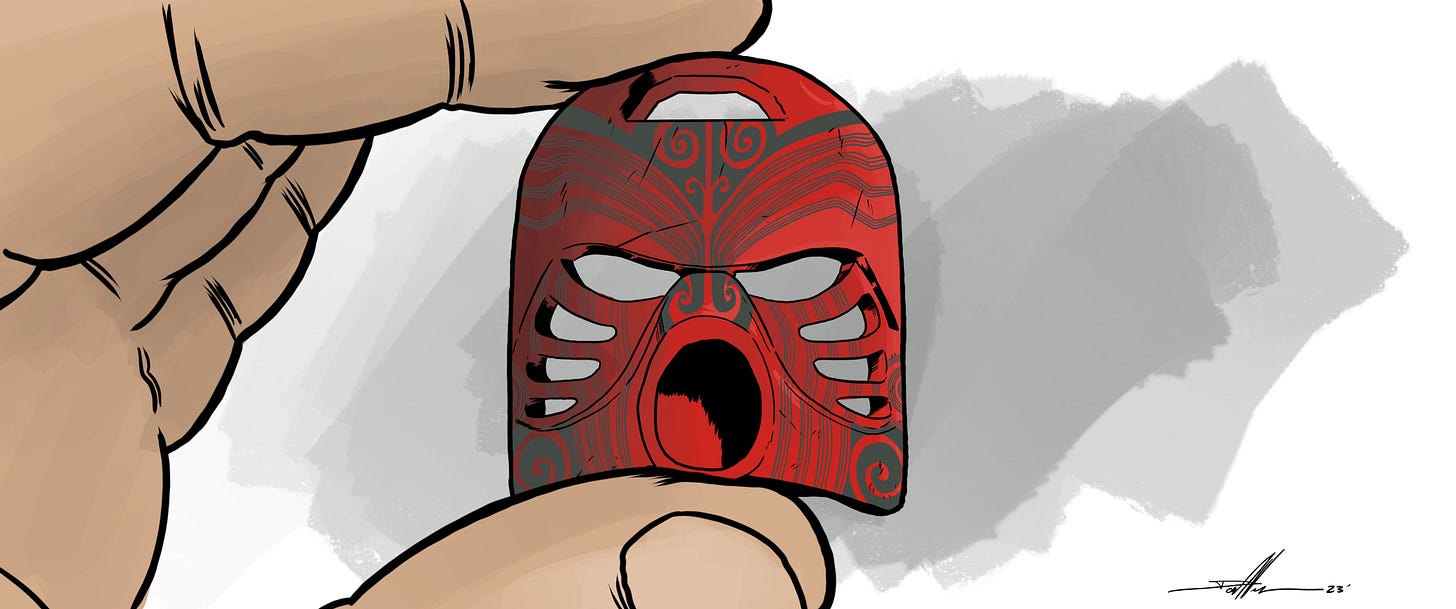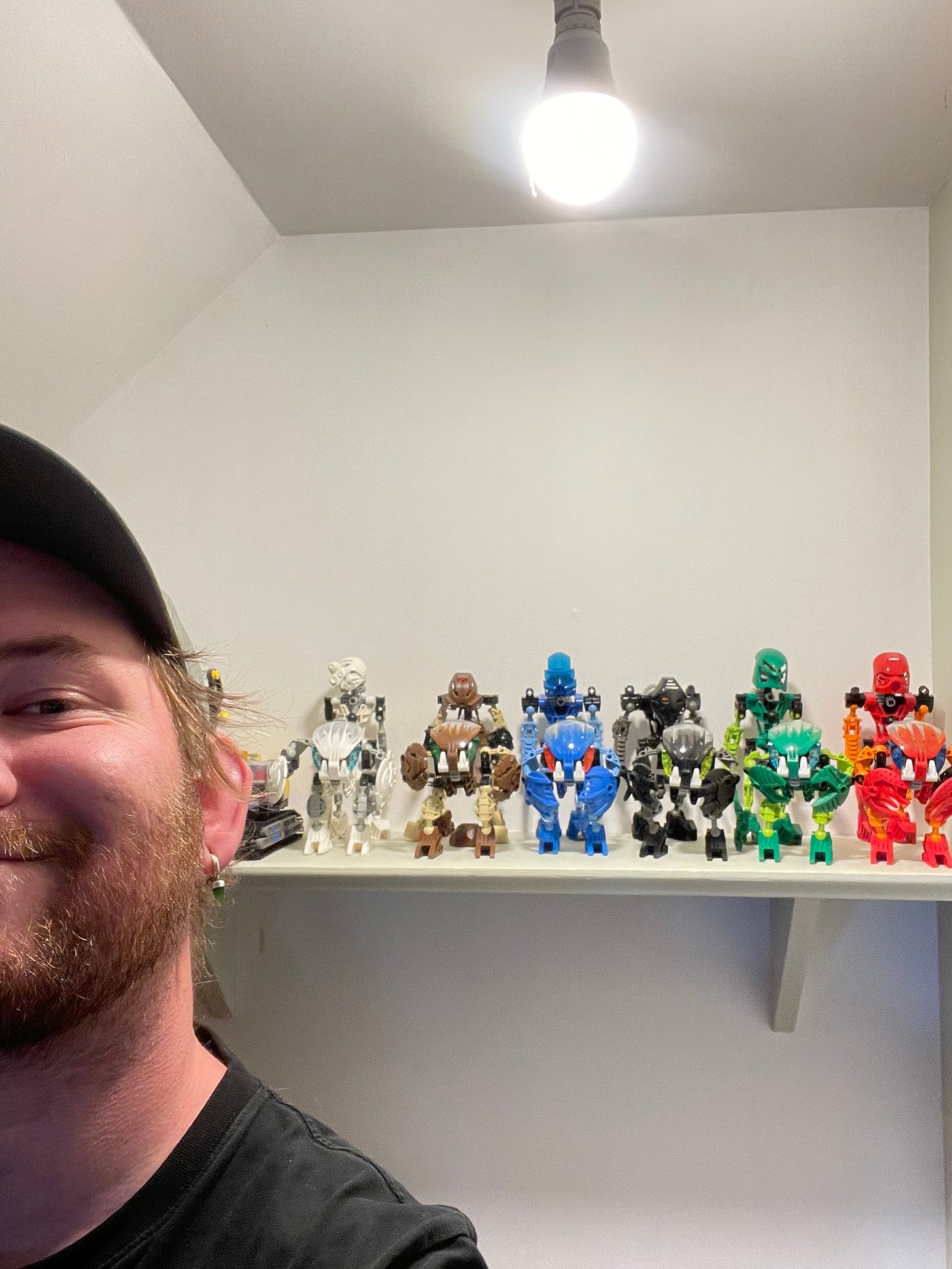How the cultural appropriation in Lego Bionicles accidentally taught me te reo Māori
And the wasted potential they had to teach our language to a whole generation.
I’m going to start this piece with a confession: In my bedroom, I have the first two generations of Lego Bionicles prominently and proudly on display on a shelf next to my bed. Now, as a single man hurtling towards thirty, one could argue that maybe this isn’t a wise decision. I would counter that having the Toa Mata and Bohrok next to the bed is the best form of protection one can have, a joke I have made more than once, don’t you worry.
Launched by Lego in the early 2000s, Bionicles quickly became a multi-million-dollar success for the company, which desperately needed a hit after dwindling sales and some bad investments in the late 1990s. Lego essentially wanted ‘buildable action figures’ set in deep sci-fi-based lore, as both action figures and sci-fi were hot at the time due to franchise hits such as Harry Potter and Star Wars.
Bionicles were an instant hit, due to a combination of their cheap price, their cross-platform marketing, and the world-building inspired by co-creator Christian Faber’s battle with a tumor at the base of his brain.
But the designs, exciting hero names, and the ‘sci-fi world’ they inhabited were also inspired heavily by something else: te reo Māori and Māori imagery and mythology. It would come as no shock that Lego did this without any consultation, acknowledgment, or reparations with Māori.
So it came as no surprise that once the successful line was launched, local iwi were rightfully pissed off. It was seen as cultural appropriation and exploitation, and they publicly criticized Lego for profiting from their cultural heritage without respecting its significance or consulting with them.
It wasn’t only just the appropriation that was insulting, it was also how the brand incorrectly used the language or outright butchered it, as you can see from the names of the heroes from the first generation of Bionicles, sourced from the Bionicle wiki:
Lego initially contested the case from Māori for greater protection of intellectual property, but after meeting lawyers and claimants representing Māori, Lego's senior executive Brian Soerensen acknowledged the company had used te reo words in the Bionicle line and agreed to draft a code of conduct for toy manufacturers wanting to use traditional imagery and language in their products.
Lego also reached an agreement with Māori to keep some names (e.g., Toa, Kanohi, Kōpaka) and to change the names of certain story elements. For example, the villagers originally known as Tohunga (skilled person, chosen expert, priest, healer) were changed to "Matoran".
I was obsessed with Bionicles when they were released, as a nerdy little dude with an overactive imagination, I was their target audience. My nan first got me a couple for my birthday, and I was hooked. They were easy to build, they looked sick-as-fuck, and I was invested in the story, which meant my imagination could run wild and I could play with them for hours and build my own universe, in my bedroom, based on their mythology.
At the age I discovered Bionicles, I was also learning basic te reo, such as my vowels, taking kapa haka, and grasping the mythology (8-year-old Danz played Māui in ‘How Māui slowed the sun’ in a gripping Paeroa Central School piece of junior theatre). So when it came to playing with Bionicles, I inadvertently pronounced the heroes’ names with a Māori vernacular, because I was spending hours playing with these figures, I was practicing subconsciously. The problem was that I was using it on incorrect words, without macrons, and without learning the correct meaning and associating it with the lore of Bionicles.
Did Bionicles help me in my pronunciation of Māori vowels? Yes. But that’s not to come to the defense of Lego and its blatant cultural appropriation. Imagine if Lego had done the due diligence and reached out to iwi, incorporating the Māori language correctly into the universe of Bionicles, it could have introduced te reo Māori to a whole generation of children at a time when there was a huge push to revitalize the language.
Imagine the after-school advertisements showcasing these mysterious, kick-ass warriors emerging from fire, scaling caves, swinging from trees and shredding snow, all the while hearing the correct pronunciation as the voice-over guy introduces each warrior and their name in Māori. All it would have taken was the minimal effort to reach out to local iwi.
Bionicles could have been an incredible way to stealth-teach some te reo, in a fun and exciting way for kids. Bionicles were also affordable for kids like me growing up on the lower end of the socioeconomic scale, with sets costing less than $15. They quickly became a staple Christmas and birthday gift, and were dutifully saved for by the money raised from recycling dads’/step-dads’ beer cans. Bionicles and their lore, language, and imagery were the product that saved Lego, and it could have been the product that revitalised te reo Māori for a generation of kids.
This isn’t an isolated case either. So much media “borrows” from Māori culture, they know we look cool, they know our language sounds powerful, and that our mythology kicks ass. Yet it still feels like an uphill battle to even get consultation and collaboration to at the very least show some respect. If you want to use our culture to sell toys, video games, movie franchises, comic books, etc, then get some consultation to not only make it accurate and cooler, but also so we can have the chance to showcase ourselves to the world correctly.
I recently purchased these sets from Trade Me so I could have the whole collection again, not only to show off to potential suitors how responsible I am with my finances, but to one day hopefully share them with my kids. But when I do, I’ll be sure to take some creative liberties—using te reo as I introduce them to the heroes and the world that once had a grip on my imagination.
Danz.







